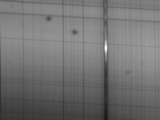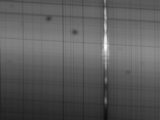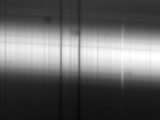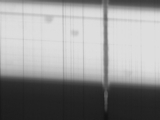THE SPECTROHELIOGRAPH
MODE OF LHIRES2 SPECTROGRAPH
UTILISATION
DE LHIRES2 EN MODE SPECTROHELIOGRAPHE
Last
update / dernière mise à jour : 3 October 2004
This note briefly describes the possibility
of LHIRES2 spectrograph
in the field of monochromatic observation of the Sun. The details
of the method is described here. For this tests the
LHIRES2 spectrograph is attached to a Takahashi FS-128 refractor. The entrance
aperture is limited to 50 mm by a diaphragm. The camera is a standard webcam
(Philips ToUcam Pro) - not modified. The spectral sampling (pixel size
of 5.6 microns) is 0.072 angstrom/pixel, so the Ha line is easily resolved.
The projected size of the slit spectrograph on the sun surface is 4.5 arcsecond.
Cette
note décrit brièvement les possibilité du spectrographe LHIRES2 pour l'observation monochromatique
du Soleil. Le détail de la technique est décrit
ici. Pour ces premiers essais
(28 aout 2004) le spectrographe LHIRES2 est fixé à l'arrière d'une lunette Takahashi
FS-128. L'ouverture d'entrée est diaphragmée à 50 mm. La caméra est une webcam
standard (Philips ToUcam Pro) - non modifiée. L'échantillonnage spectral (avec
des pixels de 5,5 microns) est de 0,072 angstrom/pixel, aussi la raie Ha
est aisément résolue. La taille angulaire projetée de la fente d'entrée du spectrographe
sur la surface solaire est de 4,5 seconde d'arc.


LHIRES2 at
the focus of the 5-inch refractor (used at the aperture of 50 mm). The
webcam is mounted at the end of the spectrograph and replace the Aude CCD camera,
it is the only difference compared to the stellar configuration. The Watek video
is a good help for select the sun region. The weight of this version
of LHIRES is 1.8 kg.
LHIRES2
au foyer de la lunette de 128 mm (utilisée à l'ouverture de 50 mm). La webcam
est montée à l'extrémité du spectrographe et remplace la caméra CCD Audine,
c'est la seule différence par rapport à la configuration utilisée pour l'observation
des étoiles. La caméra vidéo Watek facilite l'identification de la zone du Soleil
observée (ce pourrait être une seconde webcam). Le poids de cette version de
LHIRES2 est de 1,8 kg.
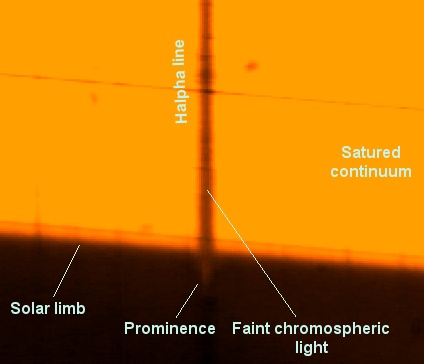
The
aspect of the Ha line (note
the generous wide of the line given by LHIRES2).
L'aspect
de la raie Ha
(on peut noter la largeur généreuse de la raie donnée par LHIRES2).
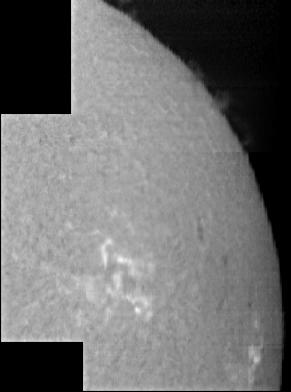
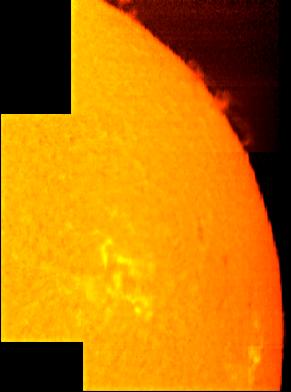
This
is the first light of LHIRES2 in the domain or solar observation (August 28,
2004). Three
scans are assembled for produce this Ha view. The contrast
of the left version is enhanced for improve the prominances vision at the
limb. The vertical shift between two adjacents line is the consequence
of a huge atmospheric turbulence during this observation. The signal of three
adjacent CCD lines are added, centered on the core of Ha. The equivalent
bandpass is of 0.25 A..
C'est
la première lumière de LHIRES2 dans le domaine de l'observation solaire (28
août 2004). Trois
balayages successifs ont été assemblé pour produire cette vue Ha.
Le contraste de la version à gauche a été accentué pour mieux voir les protubérances
en projection sur le fond de ciel. La turbulence était très forte lors de l'observation,
ce qui explique les décalages verticaux entre lignes adjacentes. Le signal est l'addition de trois lignes
adjacentes du capteur, centrée sur le cœur de la raie, ce qui donne une bande
passante de 0,25 A.
|

|

|
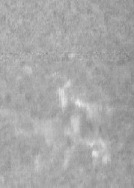
|
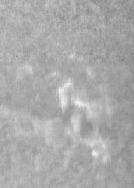
|
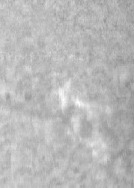
|
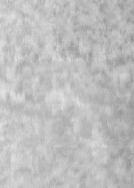
|
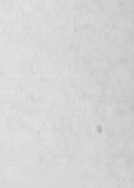
|
|
l0 - 1.00 A
|
l0 - 0.36 A
|
l0 - 0.14 A
|
l0
|
l0 + 0.14 A
|
l0 + 0.36 A
|
l0 + 1.00
A
|
Aspect of the spectroheliogam
function of the wavelength. l0 is the
approximate center of the Ha line. The relative
intensities are not respected (the core of the hydrogen line represent 20% of
the adjacent continuum).
Aspect
du spectrohéliogramme en fonction de la longueur d'onde. l0 est
la longueur d'onde approximative du centre de la raie Ha. Les intensités relatives
ne sont pas respectées (le cœur de la raie de l'hydrogène représente 20% de
l'intensité du continuum adjacent).

The
faint emission of the He I line at l5875.6 A
is detected, near
the famous yellow sodium doublet. The entrance slit of the spectrograph is nearly
tangent to the solar limb. Many dust on the detectors window are also visible
(to be corrected !).
La
faible émission de la raie de l'hélium à l5875.6
A est visible, non loin du célèbre doublet du sodium dans la partie jaune du spectre. La
fente d'entrée du spectrographe est ici pratiquement tangente au limbe solaire.
De nombreuses poussières déposées sur le hublot du capteur CCD sont aussi visibles
(à corriger !).


Comparison
of the He I (l5878
A) spectroheliogram and of the Ha spectroheliogram.
The He I image is the result of the line intensity minus adjacent continuum
(at ±0.49 angstrom relative to the line center). The horizontal lines
are artifacts (bad slit irregularity correction). Faculae appear in negative
contrast and the relative intensity of details is not the same between
the two compared lines. An impressive result if the very faint intensity of
the He I line
is taked into account !
Comparaison
du spectrohéliogramme He I (l5878
A) et du spectohéliogramme Ha.
L'image He I est l'intensité de la raie à 5878 A à laquelle on soustrait le
continuum voisin (à ±0.49 angstrom par rapport au centre de la raie). Les traits
horizontaux sont des artifacts (correction insuffisante des défauts de régularité
de la fente). Les facules apparaissent avec un contraste inversé dans la lumière
de l'hélium comparativement
à la raie Ha
et les intensités relatives des détails ne sont pas les mêmes. Ce résultat est
impressionnant compte tenu de la faiblesse de la raie en question !
The capacity of LHIRES2 to take spectroheliogram
is demonstrated. The instrument is optimized for stellar spectroscopy, so direct
visual observation of sun surface is impossible, but, the low cost and
the number of possible application compensates. It is a good alternative for
sun chrosmosphere observation. The result presented here are the very first
with LHIRES2. Some improvement are possible, but a more adapted video
camera is the first one (B&W webcam, dedicated camera, ...).
La
capacité de LHIRES2 à acquérir des spectrohéliogramme est démontrée. L'instrument
est optimisée pour la spectrographie stellaire, en particulier il n'est pas
possible d'observer visuellement les protubérances, mais, le faible coût et
le nombre d'applications possibles compenses. Il s'agit là d'une bonne alternative
pour observer la chromosphère. Les résultats présentés ici sur le Soleil sont
les tous premiers pour LHIRES2. Quelques améliorations sont possibles, la première
de toute étant une caméra mieux adaptée (webcam N&B, caméra dédiée, ...).
1 September
2004 observation
First
full disk scan
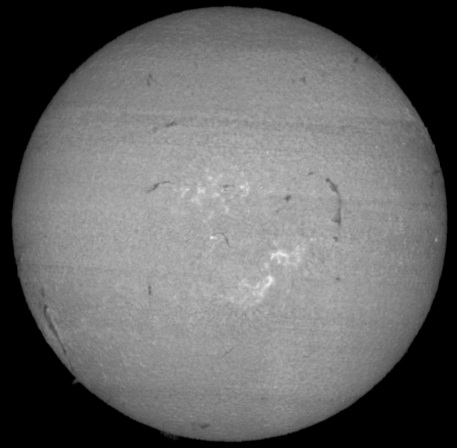

Scan
taken the 1 September 2004 around 9:10 UT. The entrance aperture of the refractor
is limited to 50 mm (2-inch). Left, an unprocessed version. Right, a wavelet
sharpened version.
Spectrohéliogramme
réalisé le 1 septembre 2004 vers 9H10 TU. L'ouverture d'entrée de la lunette
est toujours limitée à 50 mm. A gauche, une version non traité/ A droite, le
contraste a été augmenté par un filtre du type ondelette.

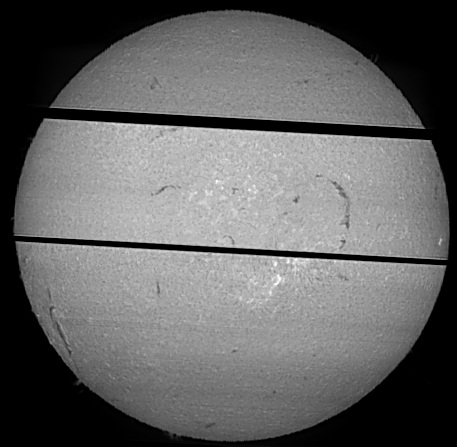
Comparison
of a scan taken the 1 September 2004 at 9H10 UT and a scan taken the 1 September
at 12:20 UT (partial, note the wide of an elementary webcam scan - remember
the focal length of the refractor is 1040 mm and the CCD chip is small, so five
scan are necessary for cover the entire disk). For the latter note a better
selection of the core of Ha
line and the high contrast of details.
Comparaison
de deux scans (balayage) réalisés le 1 septembre à 9H10 TU à gauche et à 12H20
TU à droite (ce dernier est partiel, noter la largeur du balayage élémentaire
permis par la webacm - il faut se rappeler que la distance focale de la lunette
est de 1040 mm et que la puce CCD est petite, aussi faut-il 5 scans pour couvrir
le disque en entier). L'image réalisée à 12h20 TU est très contrastée, probablement
grace à un meilleure sélection du cœur de la raie Ha
lors du traitement.

Details
of the southern prominences. Détails
des protubérances situées au sud du disque.

A
very special view of the prominences. The green component of this tri-color
image is composed by the signal of the central core of the Ha
line. For the red layer by using part of the spectrum shifted toward the red side
of Ha
line by a value of 0.33 A. For the bleue layer, we use a region of the spectrum
shifted by a value of 0.33 A toward the bleue relative to the Ha
core position. So the colors are the traduction of Doppler effects of
the gazes (i.e radial velocity). For example, the bleue feature of left
prominence come toward the observers at the velocity of about 15 km per second.
Une
vue très spéciale des protubérances. La composante rouge de cette image trichrome
est composée du signal provenant du centre de la raie Ha.
La couche rouge est obtenu en sélectionnant la partie du spectre décalée de
0,33 A vers le rouge par rapport au cœur de la raie Ha.
Pour la couche bleu le décalage est toujours de 0,33 A, mais cette fois vers
le rouge par rapport à Ha.
De fait, les couleurs sont la traduction de l'effet Doppler du gaz, c'est-à-dire
sa vitesse radiale. Par exemple, la matière du détail de couleur bleue
situé dans la protubérance de gauche se dirige vers l'observateur à une vitesse
d'environ 15 km par seconde.
You download here
a typical scan of the sun limb (file demo.avi - size 1.5 Mb). The AVI duration
is of one-minutes (a full sun can duration is normally 2-minutes). This file
is highly compressed and the quality is not very good. But you can see easily
the two prominences of the preceding images. The Ha
line is the large vertical absorption line at the center. The webcam gain is
here adjusted for saturate the photosphere for a maximum contrast of the limb
region prominences.
Vous
pouvez télécharger
ici un scan du
limbe solaire (fichier demo.avi - taille : 1,5 Mo). La durée de cet AVI
est d'une minute (alors qu'un balayage complet du disque solaire dure environ
deux minutes). Ce fichier est fortement comprimé par rapport à l'original. Il
est cependant possible d'y distinguer les deux principales protubérances des
vues ci-dessus, qui se détachent brièvement au limbe lorsque la fente d'entrée
du specrographe passe à leur niveau. La raie Ha
est la large bande au
centre. La gain de la caméra a été ici ajusté pour saturer la photosphère (et
aussi le chromosphère sur le disque) afin d'avoir un contraste maximal pour
les protubérances au limbe;
4 September
2004 observation
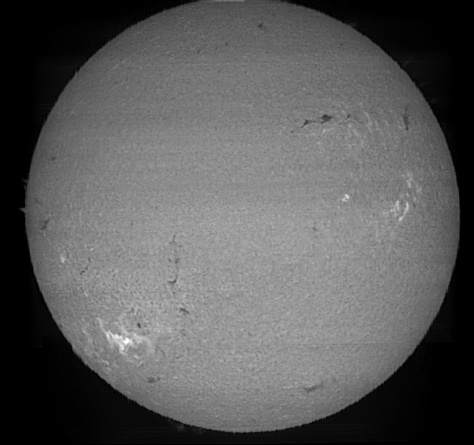
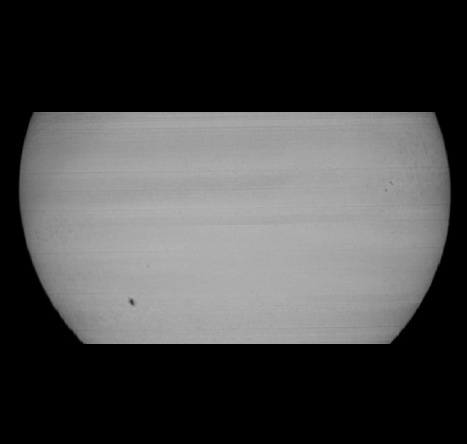
Comparison
of a Ha
image (spectroheliogram taken the 4 September 2004 at 11H30 UT) and a "white"
light image (the detector column is situated 1.5 angstroms minus the Ha
core position)..
Comparaison
d'une image Ha
(spectrohéliogramme obtenu le 4 septembre 2004), avec une image du continuum
(la ligne sélectionnée du détecteur est située à 1,5 angstroms du cœur de la
raie).
8 September
2004 observation
Doppler
spectroheliograms
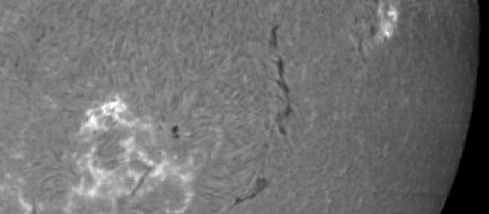
Ha - 12:15 UT
Method,
samples... click
here for details
9 September
2004 observation

Ha - 11:50 UT
13 September
2004 observation

Ha
plus possible magnetic field... click
here
16 September
2004 observation


Left,
the continuum image, right the Ha
image (0.22 Å LHIRES2 bandwidth - 14:00 UT). For the first time a modified Black
and White CCD webcam is used (Philips Vesta + Sony ICX098BL CCD - 5.6 microns
pixel size - true 0.072 Å spectral sampling). Thanks to Laurent Brouillac for the contribution! Also, for the
first time the FS-128 refractor is used at full-aperture (5-inch).
A
gauche, une image du continuum, à droite une image Ha
(bande passante de 0,22 Å avec LHIRES2 - 14H00 TU). Pour la première fois une
webcam modifiée noir et blanc est utilisée ((Philips Vesta + Sony ICX098BL CCD
- pixels de 5.6 microns). Merci à Laurent Brouillac pour sa contribution ! Pour
la première fois aussi la lunette FS-128 est utilisée à pleine ouverture.

Some
prominences (west side - 13:45 UT).
Quelques
protubérences (coté ouest - 13H45 TU)
Some (compressed - typical size: 1.2 Mo
) AVI near Ha
line and the He I 5878A line.
17 September
2004 observation

Ha
30-minutes animation (10 images between 10:04 and 10:37 UT).
Click
here for display.
|
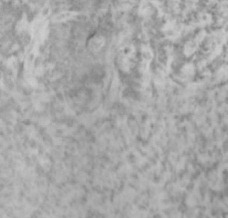
Ha
"blue wing" animation (10:04-10:37 UT). Observation
at 0.6 Angstroms off the peak, towards the blue side of the center line.
Click here for display.
|
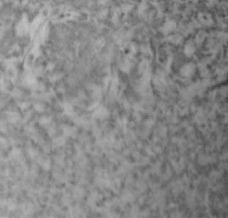
Ha
"red wing" animation (10:04-10:37 UT). Observation
at 0.6 Angstroms off the peak, towards the red side of the center line.
Click here for display.
|


A
photosphere image (left) and an H Alpha image (right) of the east group (673). 9:20
UT.
18 September
2004 observation
The active group
673 at 8:55 UT
|
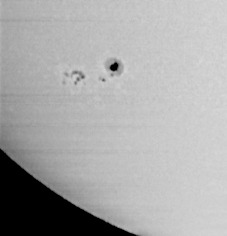
|
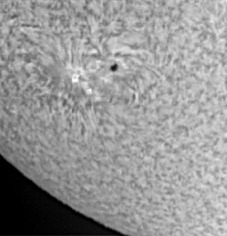
|
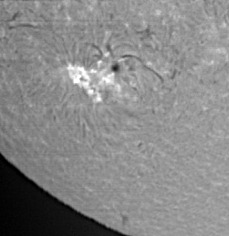
|
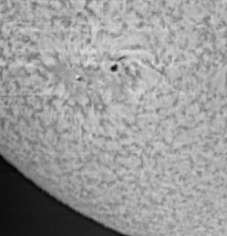
|
|
White light
|
Ha
- 0.42 Å
Click
here for a movies taken between
7:56 UT and 8:55 UT
(47 images - 670 Kb)
|
Ha
Click
here for a movies taken between
7:56 UT and 8:55 UT
(47 images - 676 Kb)
|
Ha
+ 0.42 Å
Click
here for a movies taken between
7:56 UT and 8:55 UT
(47 images - 684 Kb)
|
The active
group 672 at 9:22 UT
|

|
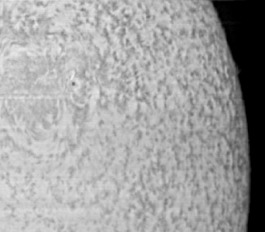
|
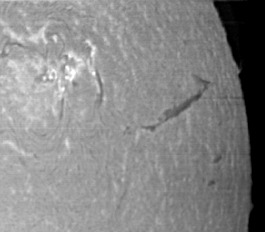
|

|
|
White light
|
Ha
- 0.42 Å
Click
here for a movies taken between
9:22 UT and 11:12 UT
(64 images - 1.1 Mb)
|
Ha
Click
here for a movies taken between
9:22 UT and 11:12 UT
(64 images - 1.2 Mb)
|
Ha
+ 0.21 Å
Click
here for a movies taken between
9:22 UT and 11:12 UT
(64 images - 1.1 Mb)
|
Part of
the active group 672 animation
First
image: 9:51 UT - Latest image: 10:39 UT
Blue wing of Ha
22 September
2004 observation
|
|

White
light - group 673
9:05 UT
|
|
|
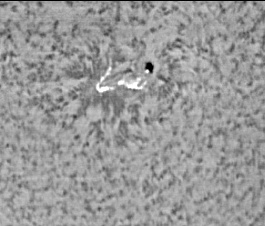
Ha
- 0.58 A
9:05 UT
|
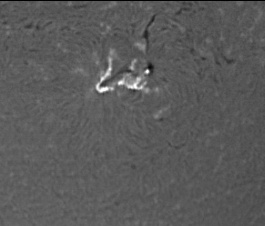
Ha
9:05 UT
|

Ha
+ 0.58 A
9:05 UT
|
|
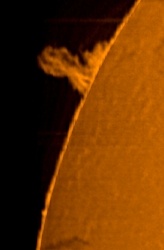
8:56
UT
|
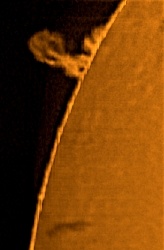
11:48
UT
|
25 September
2004 observation

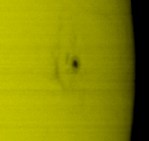
Ha
images, helium D3 images, Doppler images, Evershed effect, possible Zeeman effect, ... click
here.
28 September
2004 observation

Click
here for details
2 October
2004 observation
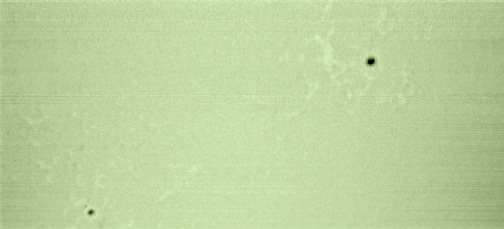
Field
1 - white light image (10:50 UT)
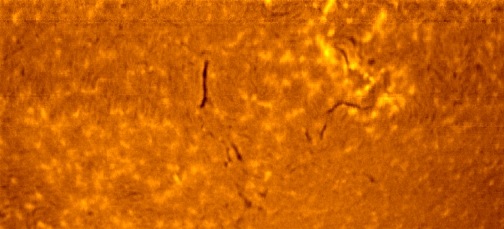
Field
1 - Ha
image (click here for display a white/Ha
animation - 140 Kb)

Field
2 - white light image (11:10 UT)
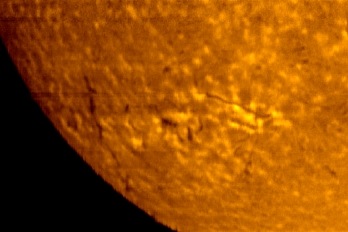
Field
2 - Ha
image (click here for display a white/Ha
animation - 140 Kb)
3 October
2004 observation
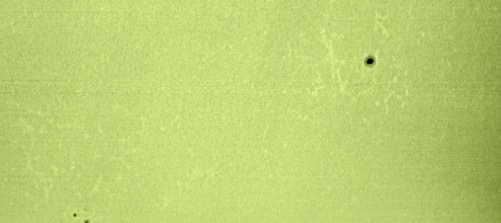

8:10
UT (Note a better seeing condition comparatively to the Oct 2, 2004 observation)
Click
here for display a movies of the sun aspect from the core of the Ha
toward the bleue wing of this line (600 Kb). Click
here for a full format version (2.8 Mb).

Click
here for display an animation of a very fast eruptive prominence
on the sun disk. The typical velocity observed is 200 km/s. Because the Doppler
shift, the prominence is totally invisible in the Ha
image. The movies correspond to a wavelength equal to Ha
core minus 1.1 angstroms for taking into account the bleue-shift of the prominence
image's. Note the fast displacement (the real duration of the sequence is of
30 minutes). Note also the brief apparition of dark spot, corresponding
to ascending large spicules. 680 Kb.


Sun
observations with the LHIRES2 spectrograph (the Vesta Pro webcam in place)
Click below the related links site about LHIRES2
and spectroheliograph.
Cliquer sur les liens ci-après concernant LHIRES2 et la spectrohéliographie.
LHIRES2
project / Le projet LHIRES2
: http://astrosurf.com/buil/lhires2/lhires2.htm
LHIRES2 first light / La
première lumière de LHIRES2 : http://astrosurf.com/buil/lhires2/fisrtlight.htm
LHIRES2
at Pic du Midi / LHIRES2
au Pic du Midi : http://astrosurf.com/buil/us/pic2004/spectro.htm
LHIRES Lithium observation in stars / LHIRES
observe le lithium dans les étoiles
: http://astrosurf.com/buil/lithium/obs.htm
ARAS
site / Le site ARAS
: http://astrosurf.com/aras
Philippe
Rousselle site / Le site de Philippe
: http://www.astrosurf.com/spectrohelio/index-gb.htm
Fred Veio site / Le site
de Fred Veio : http://www.spectrohelioscope.net/index.htm
Back




























